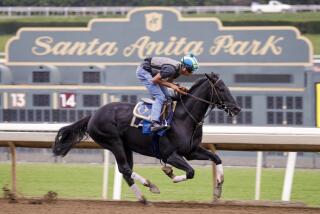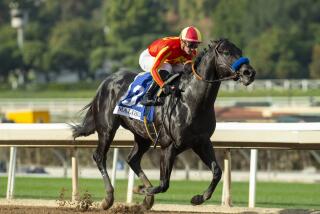Where is Seabiscuit buried?
- Share via
Make no bones about it. The location of Seabiscuit’s burial is an issue.
Friday and Saturday, as many as 100,000 horse racing fans will gather at Santa Anita to watch the Breeders’ Cup. Some may wander to the paddock, where a bronze statue commemorates Seabiscuit and his legendary 1940 victory in the Santa Anita Handicap.
Seabiscuit was an oft-injured thoroughbred whose gritty races caught the attention of an American public needing domestic heroes during the Great Depression and at wartime. Seabiscuit never won a Triple Crown race, just the devotion of an entire country. In 2001, Laura Hillenbrand wrote a book about him. In 2003, that became a hit movie.
Ask any person on the street the name of the most famous racehorse in history and, 90% of the time, you’ll get Seabiscuit or Secretariat.
In Blood-Horse magazine’s list of burial sites of the top 100 U.S. thoroughbreds, Seabiscuit is listed as being buried at owner Charles Howard’s famous Ridgewood Ranch, near Willits, in Mendocino County. The Blood-Horse burial site listing reads: “Unmarked.”
For groups of racing activists, therein lies the rub.
There is a likelihood that the bones of the fabled Seabiscuit rest directly below a paved parking lot, near several mobile homes. The more that tale becomes known, the more the movement to rectify that gathers steam. One scenario calls for the remains to be relocated under his statue at Santa Anita.
The history:
Seabiscuit retired at Ridgewood, in a special barn close to Howard’s ranch home. He died of a heart attack May 17, 1947, was placed on a sled and taken a short distance for burial. The New York Times, San Francisco Chronicle and Los Angeles Times, among others, reported that the burial would be in front of Howard’s Ridgewood home. Among those at the gravesite for the burial were Howard; his wife, Marcela; and a young girl named Laverne Jones, now Laverne Jones Booth of Hesperia; and her father, a worker on the farm.
Arriving later that afternoon to view the gravesite were Jani Griffith and her father, Chet. He was also a farm worker and his daughter, then age 10 and now Jani Buron of Dayton, Nev., has written two books about her childhood memories there — “Ridgewood Ranch, Home of Seabiscuit,” and “The Spirit of Seabiscuit.”
When Howard died in 1950, many newspapers repeated the location of the gravesite as “in front of Howard’s home.”
In 1962, the Church of the Golden Rule purchased Ridgewood Ranch, and members live and work there, to this day. In time, according to documents and interviews, things were moved around and new structures built. Land was leased to a motor home park. With the burial site of Seabiscuit lost to time and memory, an adjacent parking lot was added.
Then the movie rekindled the legend and the precise burial site became an issue. The Church of the Golden Rule continues to pay homage to Seabiscuit by running tours and seeking conservation easements to preserve historic status. But it is evasive about the exact burial site.
Tracy Livingston, former ranch manager and current head of the Seabiscuit Heritage Foundation, says Seabiscuit is buried “in a secret place, and nobody but the family was allowed to know.” In her book, Hillenbrand writes: “Howard, a vigorously public man, made his last gesture to his horse a private one. He told his only sons the location of the grave and let the oak stand as the only marker. Somewhere, in the high country that once was Ridgewood, the tree lives on, watching over the bones of Howard’s beloved Seabiscuit.”
Livingston, citing that, says, “We’re sticking to that story.”
Buron says, “Things have been moved around, but I know where the grave is. I was there. It’s in the parking lot.”
DeDe Price of Redlands, a former church member and Ridgewood resident, says the burial spot was fairly common knowledge when she was there. “He would be somewhere, basically, where they have a parking lot,” she says. “There are pictures. All you have to do is look at those. It is pretty easy to figure out.”
In 2007, when a British couple donated a third Seabiscuit statue — the second is at Saratoga — to be placed at Ridgewood, the membership took a vote on where to place it. Among the possible sites was what several knew to be the actual burial site. To demonstrate what the statue would look like there, a fake Seabiscuit, surrounded by parking cones, was placed in the parking lot. Photos compared with the original statue at the original site seem to show the exact line of hills in the background. Livingston says the parking lot statue was “speculative.”
Of the 19 church members who voted in 2007, two voted to place the statue in the parking lot. Ten voted for a placement also near the Howard home, where the statue stands now, but not on the parking lot.
Price speculates that the church won’t admit to the real gravesite because it went so long with nobody caring and now, after Hillenbrand’s book, is embarrassed about the parking lot.
“I’d be embarrassed too,” she says.
Mark Verge, Santa Anita’s chief executive, echoes that.
“If it is under the parking lot, then it’s just wrong,” he says. “The right thing is to bring it [the remains] back here. We have the money to do it. Frank Stronach [Santa Anita’s owner] is a horse lover. He’d take up a cause like this. I would think a lot of racing fans would.”
Chris Dragone, executive director of the National Museum of Racing at Saratoga, when told last year of the possibility Seabiscuit is buried under a parking lot, told Jennie Rees of the Louisville Courier-Journal, “That is not an appropriate resting place for one of the great champions of our sport.”
So, Seabiscuit may be resting in peace, but lots of his fans aren’t.
bill.dwyre@latimes.com
More to Read
Go beyond the scoreboard
Get the latest on L.A.'s teams in the daily Sports Report newsletter.
You may occasionally receive promotional content from the Los Angeles Times.











